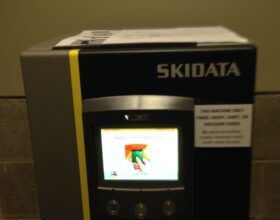Hybrids are all the rage in the era of four-buck-per-gallon gasoline because they seem so, well, sensible. And among all the sleek, shiny imaging machines gleaming like new cars on the exhibitor’s floor of the Society of Nuclear Medicine’s annual meeting, you might not notice yet another scanner tucked away in the Siemens region of the hall. But one machine was getting looks as if it were a Prius hiding in a Ferrari’s body.
Hybrids are all the rage in the era of four-buck-per-gallon gasoline because they seem so, well, sensible. And among all the sleek, shiny imaging machines gleaming like new cars on the exhibitor’s floor of the Society of Nuclear Medicine’s annual meeting, you might not notice yet another scanner tucked away in the Siemens region of the hall. But one machine was getting looks as if it were a Prius hiding in a Ferrari’s body.

This is the Biograph mMR, the only device that can acquire positron emission tomography (PET) and magnetic resonance (MR) image simultaneously. I visited with Abram Voorhees, a Ph.D. who is a Siemens business manager selling the Biograph mMR. He explained how this interesting hybrid could do more imaging using less radiation, and why fusing the two modalities was such a challenge.
“This device takes the capabilities of a conventional MRI scanner and the capabilities of a conventional PET scanner and merges them together. What’s really unique about this hybrid device is that it’s capable of simultaneous imaging: imaging the PET and mRI at the same time. All of our other hybrid devices can put these procedures close together, but they are still sequential.”
Voorhees explained that this unlocks some new applications for the device and also makes the patient experience much better because all the imaging is done at the same time. Many of us know how interminable time spent inside scanners can be. As far as new applications, a lot of the excitement around the device is in oncology because 95 percent of PET scanning today is in oncology. A lot of added value is what the MRI can bring to the PET scan in oncology. There are structures in the body that can’t be seen in PET scans, including head and neck cancer, cancers of the male and female pelvis and certain areas of the brain. “Those are areas where the MRI really shines,” said Voorhees.
Although the device is part of Siemens‘ battle plan for Alzheimer’s detection, its capabilities go well beyond that disease. When Voorhees visits a customer he usually winds up seeing a host of different departments because the utility of the device is wide. The device is better for children, for example, because there is less radiation in using MRI instead of CT scanning. So it appeals to pediatric oncology departments. The device also is widely used in cardiology, because the PET-MR combination can do a complete stress test.
Voorhees said that there are 22 worldwide installations of the device, including six in the United States at Massachusetts General, Washington University in St. Louis, NYU, the National Institutes of Health, UNC-Chapel Hill and the University of Pittsburgh. Judging by the activity on the show floor, there will be a lot of test drives in the future.







